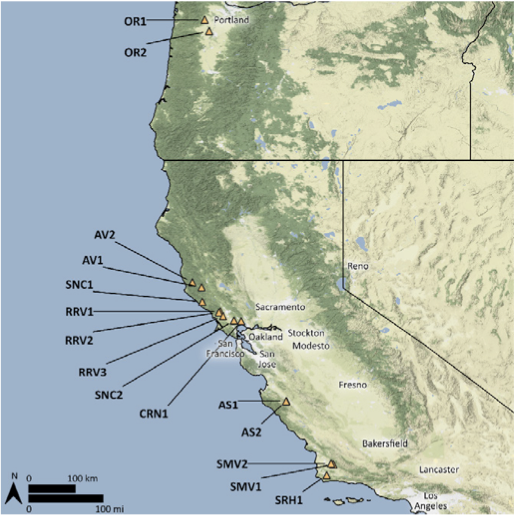Vineyard Research Cartography

California’s topography, sustainability, and climate diversity contribute to its worldwide renown in viticulture and enable researchers at UC Davis to closely examine the state’s numerous wine varieties and the conditions of their production. In a series of such projects, chemical engineer Ron C. Runnebaum and his team examine the chemical and sensorial properties of west coast-grown Pinot noirs and how they are affected by the coast’s varied topography and climate. To help readers better understand the geographic scale of this research, DataLab created a set of maps portraying the vineyard study sites for three of these papers. The maps enable readers to more clearly visualize the locations and topographical features of each vineyard site and highlight the overall scope of each project.
This project examines the differences in aroma, taste, mouthfeel, and chemical composition among Pinot noir wines made from a single clone grape grown across 12 California vineyards. Despite the similar genetic profile of the grapes and standardized winemaking practices, the wines contained unique chemical and sensorial profiles across the aging process. The researchers determined that the location of the vineyard is one of the main factors in developing these differences, though soil type, rootstock age, soil pH, and other factors also contribute. These findings are especially critical for wineries and winemakers who wish to emphasize special or unique characteristics of their vineyard or region.

This paper investigated the reproducibility of 30 different elements in the chemical profile of Pinot noir wines from 2015 and 2016 grown using a single clone variety of grape. These grapes were grown in 14 different vineyards across the widely varied topography from Oregon to Southern California. 19 of the 30 elements were proven to be reproducible in wines from 8 vineyards. By comparing the elemental profiles of these Pinot noirs, the researchers concluded that the origin and growing site factors of each vineyard are directly correlated with the elemental profile of the wine.

In order to help winemakers along the U.S. west coast determine the effects of smoke on their Pinot noirs from year to year, this study examined smoke exposure marker compounds to better understand the impact of wildfire smoke on individual wines. The researchers determined that the baseline concentrations of the studied smoke impact markers were low in this particular group of Pinot noirs, but suggest that west coast winemakers familiarize themselves with baseline concentrations in order to determine wildfire risk to particular wine vintages.


